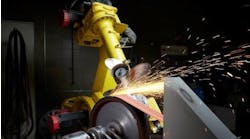Are Engineering Schools the Unsung Hero in America's Industrial Rebound?
There's no doubt the manufacturing sector of American industry has stormed back. All the statistics, investments, jobs and growth patterns demonstrate a major turnaround.
The National Association of Manufacturers (NAM) reports that "global economic conditions are also making the United States a more attractive platform for exports. In fact, manufacturers based abroad are investing in the United States -- not simply to serve domestic markets but as a base for exports."
NAM notes the foreign direct investment in manufacturing in America has jumped from $476.5 billion in 2001 to $838.3 billion in 2011 with estimates for 2012 even higher.
A recent Time magazine cover story announced that "Made in the USA is Making a Comeback." Time reported "The U.S. has seen its manufacturing growth outpace that of other advanced nations, with some 500,000 jobs created in the past three years. It marks the first time in more than a decade that the number of factory jobs has gone up instead of down.”
Two sectors are correctly credited for this success, industry and government. Industry has successfully retooled, reinvested, restructured and implemented new technologies and processes. Government bailed out General Motors in 2008 and since been repaid while the American auto industry asserts itself as a world leader and contributes billions to the national economy.
President Obama's Advanced Manufacturing Partnership signals more partnerships ahead. The White House press release noted: “… We must invest to win the future. Investments will be made in the following key areas: building domestic manufacturing capabilities in critical national security industries; reducing the time needed to make advanced materials used in manufacturing products; establishing U.S. leadership in next-generation robotics; increasing the energy efficiency of manufacturing processes; and developing new technologies that will dramatically reduce the time required to design, build, and test manufactured goods.”
But a third, vital engine powering the recovery has been mostly overlooked, the nation's engineering schools. Groundbreaking research, cutting-edge systems and partnerships with industry and government have resulted in new technologies and paradigms that have transformed American industry, and will continue to bolster American competitiveness for the next decade.
Private and academic partnerships are nothing new. However, the sheer scope and ambitiousness of the collaboration, along with the unparalleled success in transforming the technologies and implementing them into industry, makes the new models of cooperation much more powerful. It’s a fantastic investment that benefits industry, workers, stockholders and the overall economy. At a time when calls for cutbacks and austerity are commonly heard, government and business need to spend more, not less, on these vital partnerships that improves the competitiveness of American industry.
At Vanderbilt University’s Engineering School, our major research center is ISIS, the Institute for Software Integrated Systems. ISIS conducts basic and applied research in the area of systems and information science and engineering. There are three major breakthroughs accomplished by engineering schools that directly benefit the manufacturing industry:
-
Open Source Software - The move from proprietary to open source software is a major revolution spearheaded by academics. At Vanderbilt, ISIS developed an open source suite of tools that is available to everyone in the industry to optimize design while considering manufacturability constraints. For example, 30 years ago in the semiconductor industry, engineers who were designing the circuit, those who were making them, and those who were packaging them were all integrated in the same place; everybody was developing their own proprietary tools.
-
Advanced Manufacturing - Fast forward to today. Advanced modeling and verification tools and precise knowledge about manufacturing processes restructured the VLSI industry into fabless design houses and foundries. Open source software allows rapid progress in this direction across all industries. Truly advanced manufacturing creates better, higher paying jobs in this country. The automobile and aerospace industries have access to the most state of the art tools to design their products more efficiently and create a better workflow and supply chain. Paul Fowler of the National Council for Advanced Manufacturing (NACFAM) defines advanced manufacturing as “an entity that: Makes extensive use of computer, high precision, and information technologies integrated with a high performance work force in a production system capable of furnishing a heterogeneous mix of products in small or large volumes with both the efficiency of mass production and the flexibility of custom manufacturing in order to respond rapidly to customer demands.”
- Highly Skilled Workforce - Academic research continues to focus on expanding the frontiers of knowledge, but this is not enough. Today, researchers team up with industry more directly. The challenges come from industry, but it is the schools of engineering with their emphasis on longer term research that create the breakthroughs that industry adopts. Last year our students were instrumental in the process of developing integrated manufacturing aware design tools used in a national contest for developing the power train of the next amphibious vehicle for the U.S. Marine Corp. Other student projects includetesting models for vehicle components, testing the tools, and participating in a friendly competition with MIT and UC Berkeley students to design and build a small amphibious vehicle as a dry-run for the national contest.
Partnering with Boeing
Here’s one example of industry and academic partnership. ISIS has a long-term collaboration with Boeing focusing on the foundations and applications of model-based tools spans over two decades. One of the early projects in the nineties focused on the model-based “diagnosability” analysis tool for the International Space Station that was used in the program development.
Between 2000 and 2004, ISIS worked with Boeing researchers on creating and testing new tools for model-based design of embedded software systems. Between 2005 and 2009, ISIS was a significant contributor to the Boeing FCS program by developing a model-based software integration tool suite for the program. The latest collaborations include joint projects in DARPA’s AVM Adaptive Vehicle Make (AVM) and Boeing’s licensing of ISIS technology for on-board aircraft diagnostic systems. Of course these endeavors are very complex and require a large number of researchers and students. Hence, many of the projects, such as those in DARPA’s AVM program, are conducted in collaboration with leading schools of engineering – in this case Vanderbilt, MIT, and Georgia Tech.
In economic terms, the partnership between industry and business, and in some cases government, is more than a success story that has reenergized the industrial base. It’s a fantastic investment that benefits industry, workers, academics and the general public. Of course, engineering schools aren’t the only contributor to the fantastic advances in American manufacturing. But as a significant contributor and innovator in this process, it would only be fair to give academics credit for their part in this revival.
Philippe M. Fauchet is the Dean and Professor of Electrical Engineering at the Vanderbilt University School of Engineering.





